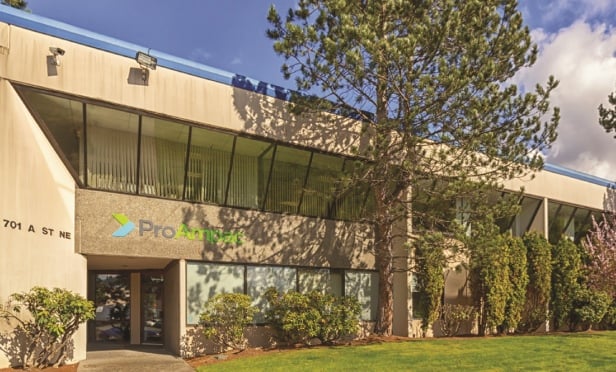LOS ANGELES-Vacancy keeps climbing, rents continue downward and net absorption remains negative in Los Angeles County's office market, but there are some positive signs that don't necessarily show up in the latest stats and could be harbingers of at least a bottoming out for the market. Whitley Collins, regional managing director for Los Angeles brokerage at Jones Lang LaSalle, tells GlobeSt.com that although the company's newly released third-quarter statistics show the same general weaknesses that have defined the market for two years now, "There are some good things happening that may not have shown up yet in the stats."

"You could call it the bottoming of the market," Collins says. "People are feeling that if it isn't the bottom, we're getting close, although you can never say you are in the bottom until you can look back and see that you've passed it."
Total vacancy climbed to 18.1% in the third quarter, compared with 16.6% in the third quarter of last year. Average asking rents slid to $31.59 per square foot per year versus $33 a year ago, according to the JLL report, although Collins says that deals today are being done below the asking rates. The market posted more than 458,000 square feet of total negative net absorption in the quarter for a total negative net of nearly two million square feet year-to-date on an inventory of more than 181 million square feet of office space in the county.
Collins expects that the same trends of the past two years will continue throughout 2011, with vacancy remaining high and rents continuing to slide, although at slower rates. The region's and the state's high unemployment, all-important to the office market, will probably take three to five years to solve, Collins says, but he estimates that the office market could show some signs of improvement in 2012.

Meanwhile, however, the JLL regional managing director cites some trends that will produce some positive signs amid the continued weakness. "In the third quarter we began to see some transactions getting done, and I think there are some large deals set to close in the fourth quarter. I think we are going to have a good fourth quarter and to see some more velocity" in leasing, he says.
To be clear, Collins explains, this doesn't mean that the market is on a rebound or that it will exhibit a great deal of strength. "It just means that people are now thinking, 'OK, we are not headed for catastrophe,' " and those people are willing to make some decisions that they delayed in the past. "If you look back two years, people were fearful of that (catastrophe)," but what has happened since is that decision-makers have determined that conditions are not likely to worsen too much despite the unemployment problem and "fundamentals that aren't great.
One of the changes that Collins expects to see in 2011 is that tenants will be more willing to make long-term commitments in order to save money on rent in the long run by reducing the amount of space they occupy. "I don't know one company that hasn't had a directive to cut office space," typically by about 25%, he says. He explains that many office tenants could save substantial amounts in rent over a 10-year lease if they were willing to shoulder the up-front costs of moving to less expensive space, but they have been reluctant to spend that up-front capital.
"A lot of people right now are renewing in space that's older and less efficient than they would like, but they don't want to spend the money to get more efficient space. I think that is gradually going to change," Collins says. He says that tenants will opt either to move out of their existing buildings or move to different floors within those buildings because reducing total occupied space isn't just a matter of giving some space back to the landlord. "To do it, you have to spend the money to build out new space," he says. He cites the legal profession as an example. "Law firms today typically have three times as many secretarial spaces as they need. It's really hard to spend just a few dollars to redo them now. To get efficient, you can't band-aid the space, you have to go to new space." The same holds true for banking, accounting and other industries, he adds.
When California's employment picture does eventually begin to improve, Collins says that it will take some time to translate into lower vacancy and higher demand in the office market. He explains that so-called shadow space, which tenants are renting but not using, will need to be filled before those tenants need additional space. "Shadow space is a bigger number now than anyone understands, and the bigger it gets, the longer it will take for things to recover," he says.
Another factor that will affect the recovery is the composition of the Los Angeles County office market, which consists of a relatively small central business district and many suburban markets, Collins points out. General economic conditions affect all of those markets, but because L.A. is composed of so many smaller markets, conditions can vary significantly from one to the other, often depending on which industries drive the specific market.
Conventional thinking for the past 20 years or so has posited that when a recovery does get under way, the commercial real estate industry typically trails it by six months. This time, however, Collins says that the industry is likely to trail the recovery by about 12 to 18 months.
Collins also points out that the leasing and investment sales markets are on different tracks. While leasing has remained weak, investment sales have perked up and prices have been rising. As an example, he cites the recent $208 million sale of the 627,334-square-foot Union Bank Plaza office tower in Downtown Los Angeles, a transaction in which JLL represented the seller, Hines. The $208 million price tag compares with the $140 million that Hines paid for the building in March 2005, according to a previous GlobeSt.com report.
© Touchpoint Markets, All Rights Reserved. Request academic re-use from www.copyright.com. All other uses, submit a request to [email protected]. For more inforrmation visit Asset & Logo Licensing.






